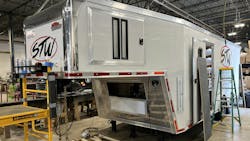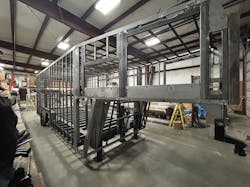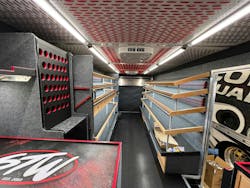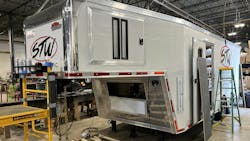Tool truck vs. tool trailer: What is best for your mobile tool store?
Key Highlights
- The pros and cons of using a mobile tool truck as your storefront.
- The pros and cons of using a tool trailer and truck as your storefront.
- Understand the proper specifications (size, layout, and construction) needed for a mobile tool trailer.
- Insights from a mobile tool distributor who's used tool trailers for years.
Your mobile tool business is going well; your inventory keeps growing as tool manufacturers offer more new products to meet your customers’ needs as vehicles continue to evolve. It might be time for a new mobile tool store.
Perhaps your store looks a little tired with a lot of miles and years on it, and doesn’t lend itself to properly displaying today’s range of tools and equipment. A new mobile tool store can generate excitement and sales as it drives traffic to your store, and a great layout can help increase your sales and efficiency.
There are many choices for mobile tool trucks today. Step van or cab and chassis configuration? Diesel, gas, or hybrid powertrain? GVWR/payload capacity? Size?
Many decisions are also needed for a trailer: Bumper pull (tag) or gooseneck trailer? Length? GVWR/payload? Tow vehicle? As with tool trucks, your route, inventory, interior layout, and budget will decide your trailer and tow vehicle needs.
The cost of step vans and cab and chassis tool trucks have risen dramatically, and truck downtime (often due to diesel emissions-related issues) is increasingly a problem. Mobile tool distributors are increasingly opting to use custom trailers for their mobile stores. Potential benefits include lower initial investment, reduced downtime, lower maintenance costs, and the flexibility of separating the tool store from the powered vehicle.
How do you decide which is right for you? Let’s look at the pros and cons of each.
Traditional tool truck
Pros
- Many tool truck builders to choose from
- Used units are readily available
- Familiar, proven interior layouts and options
- May be able to use engine-driven A/C and hot water heat versus generator, roof A/C, and propane or diesel furnaces)
- Trade-in/resale values are well established
- Familiar finance/insurance options
- Potentially better maneuverability in more congested routes
Cons
- High initial investment
- Increasing maintenance costs and downtime
- Inventory is potentially vulnerable when the tool truck is at the service facility
- Higher/steeper steps to cab and into body of tool truck (becoming an issue for our aging customer base)
- Inherent danger of loading tool cabinets and equipment using liftgates, and the size limitations of liftgates
- Typical “truck” ergonomics and creature comforts in the cab
- Limited number of service facilities for repair and maintenance
Tool trailer and truck
Pros
- Potentially lower initial investment
- Separate power unit from tool store (can use alternate tow vehicle during maintenance/downtime of tow vehicle)
- Can use tow vehicle to tow another trailer (open or enclosed for focused promotions), or tow your camper or race car trailer on the weekends
- Can upgrade/replace tow vehicle without replacing the existing tool store
- Less steps into the tool store and the cab of the tow vehicle
- Ramp door for loading tool storage units and equipment
- Many service facility options for trucks and trailers
- Minimal maintenance needed on trailer (bearing lubrication/adjustment, brake adjustment/replacement)
- The tow vehicle can be used to run route if trailer is down for service
More articles from The Truck Stop series:
Cons
- Potentially harder to maneuver in tight areas
- Trade-in or resale potential may be limited
- Financing/insurance/licensing of multiple vehicles required
- Limited number of vendors building turn-key tool trailers
- You need to exit the tow vehicle and walk from the truck to the trailer to enter your store
- Likely requires a generator for climate control
Spec'ing a mobile tool trailer
The process of researching and spec’ing out a tool truck is a familiar topic for most, so let’s discuss the lesser-known choice of the mobile tool trailer.
Size
First, what size trailer? You are going to want a trailer with an interior height of 7’, that’s about the max height to easily reach tools laced on the ceiling. An 8.5’ wide trailer gives you 96” between the walls to allow adequate aisle width. As far as box length, 20’ to 24’ bumper pull trailers or 28’ to 32’ Gooseneck trailers (20’-24’ box with 8’ gooseneck) are common and closely match the interior showroom space of conventional tool trucks with 20’ to 24’ boxes. Gooseneck trailers tend to be more maneuverable and provide better ride quality than bumper pull units.
Interior layout
The options and layouts for trailer interiors closely mirror those of traditional tool trucks. Climate control options usually include propane furnaces with tanks mounted on the tongue of bumper pull trailers or in the bunk areas of gooseneck trailers, and gas or diesel generators sized to run one or two roof A/C units. Generators can be mounted on the tongue of bumper pull trailers (or, often, the generator is mounted in the truck bed) or in the bunk area of gooseneck trailers. A popular option is to include a fuel tank for the generator mounted below the floor of the trailer between the frame rails.
Construction
An important consideration is to start with a trailer properly constructed for the application. Enclosed trailers are not designed to support heavy loads on the ceiling and side walls, which is exactly what we do in our mobile tool stores. Twelve-inch on-center floor crossmembers, wall posts, and roof bows would be highly recommended, as would a trailer featuring single or double I-beam construction frame rails. Torsion axles with the proper capacity and hubs, wheels, tires, and brakes suited for the application are necessary.
Inside insights on using a trailer
James Stinson owns a three-generation mobile tool business that has used tool trailers as mobile stores since 2003. Currently, Stinson and his son Evan run two routes in Georgia. Stinson cites lower initial cost, ease of maintenance and repairs, and flexibility as the key benefits of using trailers. He also notes, “being able to drop the trailer and take care of something elsewhere in the route” is a real convenience, and “being able to swap out the tow vehicle in case of downtime on the primary tow vehicle lets me keep my business up and running.”
Today, a 22’-24’ tool truck built on the popular Freightliner M2 chassis will likely require an investment of $225-$250K. The cost of the interior build-out (your retail store) is about the same for a tool truck or tool trailer, and the costs for generator, furnace, and A/C installations are similar as well.
The cost of the trailer represents about 20-30 percent of the total cost of the finished store. Stinson tells how he “purchased a new trailer in 2021 and spent a lot of money on the interior conversion” only to have ongoing structural, axle, and brake problems.
“I tried to save money by buying an inexpensive trailer that proved not to be suited for this application," he says, "so the money spent on the upfitting of the trailer has gone to waste.”
Stinson visited the Jason Dietsch Trailer Sales/ United Trailer booth at the 2024 ISN Tool Expo in Orlando.
“I was amazed at the quality of the trailer they had on display and their willingness to take the time to listen to my needs," he says. "I ended up ordering two 28’ United Trailers Commercial Cargo Gooseneck Trailers and having them built out at Herr Display Vans. Herr Display Vans and United Trailers worked together to build me exactly what I wanted for my businesses.”
The custom trailer as a mobile tool store is a practical alternative, and it may be worth considering for your next store. Do your homework and find the right solution for your business!
About the Author

Bob Bischak
Bob Bischak is the director of sales for United Trailers, a leading manufacturer of enclosed cargo and race car trailers. Bischak began his career as an engineer in the automotive industry prior to 18 years as a mobile tool distributor and 15 years in management at a major tool company.



